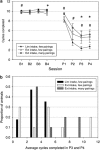Drug intake is sufficient, but conditioning is not necessary for the emergence of compulsive cocaine seeking after extended self-administration
- PMID: 22334124
- PMCID: PMC3358752
- DOI: 10.1038/npp.2012.6
Drug intake is sufficient, but conditioning is not necessary for the emergence of compulsive cocaine seeking after extended self-administration
Abstract
Compulsive drug seeking, which is characterized by continued instrumental effort despite contingent punishment, has been shown to emerge after extended drug self-administration. Exactly what aspect of drug self-administration drives the appearance of addictive behavior is unclear, but the mechanistic explanations that have been offered differ in one key respect. On one hand, it has been suggested that dysfunctional conditioning during self-administration drives unrealistic reward expectations, ultimately producing resistance to punishment. If this is indeed the pathological process that drives compulsive behavior, then compulsivity should be apparent only in the presence of the pavlovian and instrumental stimuli that underwent frequent pairing with the drug reward. On the other hand, it has also been suggested that extended drug intake produces general changes to reward and decision-making circuits that manifest as compulsive drug seeking. Unfortunately, conditioning history and drug intake are generally intrinsically intertwined. However, here we used an animal model of compulsive cocaine seeking to selectively manipulate drug intake and the degree of conditioning in the test context, to investigate which of the two is more important for the emergence of compulsive cocaine seeking. The results show that extended drug intake alone is sufficient, but extended conditioning in the test context is not necessary for the emergence of compulsive cocaine seeking, resolving a fundamental question in addiction research.
Figures





Similar articles
-
Using conditioned suppression to investigate compulsive drug seeking in rats.Drug Alcohol Depend. 2014 Sep 1;142:314-24. doi: 10.1016/j.drugalcdep.2014.06.037. Epub 2014 Jul 8. Drug Alcohol Depend. 2014. PMID: 25060961
-
Sign- and goal-tracking score does not correlate with addiction-like behavior following prolonged cocaine self-administration.Psychopharmacology (Berl). 2021 Aug;238(8):2335-2346. doi: 10.1007/s00213-021-05858-z. Epub 2021 May 5. Psychopharmacology (Berl). 2021. PMID: 33950271 Free PMC article.
-
Pavlovian-to-instrumental transfer in cocaine seeking rats.Behav Neurosci. 2012 Oct;126(5):681-9. doi: 10.1037/a0029534. Epub 2012 Aug 6. Behav Neurosci. 2012. PMID: 22866668 Free PMC article.
-
Differential vulnerability to the punishment of cocaine related behaviours: effects of locus of punishment, cocaine taking history and alternative reinforcer availability.Psychopharmacology (Berl). 2015 Jan;232(1):125-34. doi: 10.1007/s00213-014-3648-5. Epub 2014 Jun 21. Psychopharmacology (Berl). 2015. PMID: 24952093 Free PMC article.
-
Impact of repeated intravenous cocaine administration on incentive motivation depends on mode of drug delivery.Addict Biol. 2014 Nov;19(6):965-71. doi: 10.1111/adb.12063. Epub 2013 May 3. Addict Biol. 2014. PMID: 23639056 Free PMC article.
Cited by
-
Addiction is a Reward Deficit and Stress Surfeit Disorder.Front Psychiatry. 2013 Aug 1;4:72. doi: 10.3389/fpsyt.2013.00072. eCollection 2013. Front Psychiatry. 2013. PMID: 23914176 Free PMC article.
-
Incubation of cocaine seeking following brief cocaine experience in mice is enhanced by mGluR1 blockade.J Neurosci. 2014 Jan 29;34(5):1781-90. doi: 10.1523/jneurosci.1076-13.2014. J Neurosci. 2014. PMID: 24478360 Free PMC article.
-
Reward Prediction Errors in Drug Addiction and Parkinson's Disease: from Neurophysiology to Neuroimaging.Curr Neurol Neurosci Rep. 2017 Jun;17(6):46. doi: 10.1007/s11910-017-0755-9. Curr Neurol Neurosci Rep. 2017. PMID: 28417291 Review.
-
Addiction is driven by excessive goal-directed drug choice under negative affect: translational critique of habit and compulsion theory.Neuropsychopharmacology. 2020 Apr;45(5):720-735. doi: 10.1038/s41386-020-0600-8. Epub 2020 Jan 6. Neuropsychopharmacology. 2020. PMID: 31905368 Free PMC article. Review.
-
Behavioral and neural mechanisms underlying habitual and compulsive drug seeking.Prog Neuropsychopharmacol Biol Psychiatry. 2018 Dec 20;87(Pt A):11-21. doi: 10.1016/j.pnpbp.2017.09.003. Epub 2017 Sep 5. Prog Neuropsychopharmacol Biol Psychiatry. 2018. PMID: 28887182 Free PMC article. Review.
References
-
- Ahmed SH, Kenny PJ, Koob GF, Markou A. Neurobiological evidence for hedonic allostasis associated with escalating cocaine use. Nat Neurosci. 2002;5:625–626. - PubMed
-
- Arroyo M, Markou A, Robbins TW, Everitt BJ. Acquisition, maintenance and reinstatement of intravenous cocaine self-administration under a second-order schedule of reinforcement in rats: effects of conditioned cues and continuous access to cocaine. Psychopharmacology. 1998;140:331–344. - PubMed
-
- Berke JD, Hyman SE. Addiction, dopamine, and the molecular mechanisms of memory. Neuron. 2000;25:515–532. - PubMed
-
- Cardinal RN. Whisker, version 1.0 2001.
-
- Cardinal RN, Everitt BJ. Neural and psychological mechanisms underlying appetitive learning: links to drug addiction. Curr Opin Neurobiol. 2004;14:156–162. - PubMed
MeSH terms
Substances
Grants and funding
LinkOut - more resources
Full Text Sources

